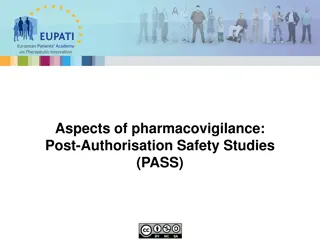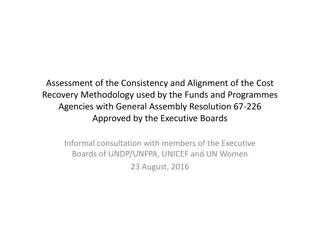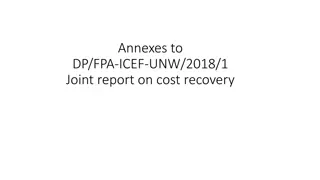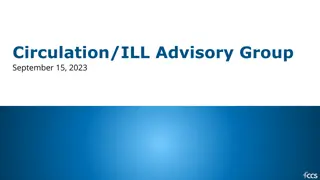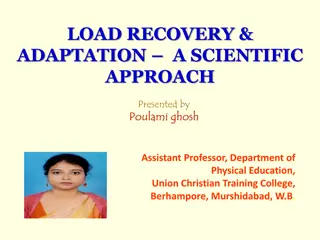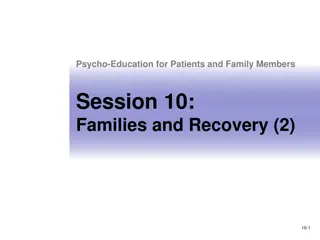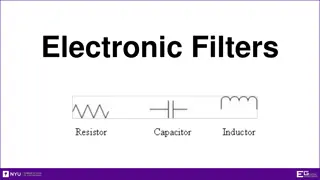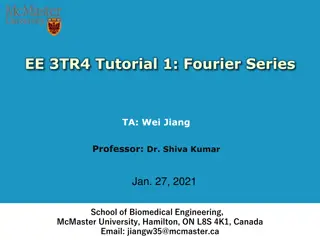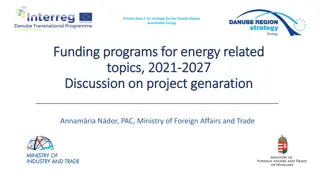Challenges and Solutions in CBETA 4-Pass Energy Recovery System
Explore the challenges faced and solutions attempted during the operation and commissioning of the CBETA 4-pass Energy Recovery System. Topics include beam measurements, BPMs, power supply stability, orbit correction, and more. The presentation delves into expected and unexpected issues encountered, with insights on microphonics, component failures, and optimizing machine reproducibility for successful operations.
Download Presentation

Please find below an Image/Link to download the presentation.
The content on the website is provided AS IS for your information and personal use only. It may not be sold, licensed, or shared on other websites without obtaining consent from the author. Download presentation by click this link. If you encounter any issues during the download, it is possible that the publisher has removed the file from their server.
E N D
Presentation Transcript
CBETA: 4 Pass Energy Recovery Challenges Adam Bartnik acb20@ acb20@cornell.edu Jan 12, 2022 PERLE Seminar
Quick CBETA Overview Multi-pass ERL, with single return loop 7 beams of 4 energies in 1 pipe: 42, 78, 114, 150 MeV Uses the wide energy acceptance of Fixed Field Alternating-gradient (FFA) permanent magnets FFA Return Loop 2 acb20@ acb20@cornell.edu Jan 12, 2022 PERLE Seminar
4 Pass Commissioning Timeline Primary goal: 4 pass ERL operation at the commissioning current of 1 nA (FFA radiation limit) 12 weeks of operation, ending Dec. 31st2019 Progress was not steady, often determined by problem solving 3 acb20@ acb20@cornell.edu Jan 12, 2022 PERLE Seminar
Talk Organization Problems & Solutions What types of challenges did we face? What types of solutions did we try? Were we successful? Results example data from 4-pass operation Expected challenges Unexpected challenges Microphonics Component failures BPMs for many beams Magnet power supply instability Multi-beam orbit correction Path length adjustment Stray fields MLC slow energy drift Dispersion/R56 correction Beam arrival phase drift Laser leakage current Matching lattice optics Machine reproducibility, degaussing Microbunching instability strikethrough = Included in extra slides 4 acb20@ acb20@cornell.edu Jan 12, 2022 PERLE Seminar
BPMs for Many Beams One of the biggest challenges is the ability to measure up to 8 different beams at a single location, and to do it reliably when there is only 1 nA of current. Two kinds of BPMs 1. Time domain BPMs : Position only 2. RF BPMs : Position and phase (arrival time) = RF BPM 5 acb20@ acb20@cornell.edu Jan 12, 2022 PERLE Seminar
Time domain BPMs Digitize BPM response Single bunch response: 3 ns ADC rate: 2.5 ns Single bunch response Original plan: Synchronize BPMs to (every other) peak Problems: Time-consuming to set up = ADC sampled points Each pass has different timing Laser hiccups cause timing to be lost (extra slides) Bunch spacing = 23.8 ns 8 bunches passing by BPM twice Round-trip time = 264 ns 6 acb20@ acb20@cornell.edu Jan 12, 2022 PERLE Seminar
Time domain BPMs Solution: Asynchronous timing : Sample random part of a bunch response Synchronous BPM ADC: (1300/31)x(76/2)/4 = 398.4 MHz Asynchronous BPM ADC: (1300/31)x(73/2)/4 = 382.6 MHz Synchronous Asynchronous Bad: Good: Simple, stable, details of timing no longer matter Lose about a factor of 5 in signal 7 acb20@ acb20@cornell.edu Jan 12, 2022 PERLE Seminar
Phase (RF) BPMs Original plan: Two frequency mixing (f0and 2 f0) to measure 2 simultaneous beams Commissioning plan: Use trains of 8 bunches, so that passes do not overlap in time Good: single frequency (f0) , same as injector BPMs (well understood) Good: can use locations with more than 2 beams (e.g. linac entrance/exit) Bad: cannot be used with long bunch trains, e.g. high current 1stpass 2ndpass 8 acb20@ acb20@cornell.edu Jan 12, 2022 PERLE Seminar
Stray fields Splitter magnet density was expected to be a significant problem Largest expected problems: septa magnets Field clamps from detailed modeling, engineering Reduced stray field effect by factor of 40 No time for engineering, nor space for clamps around other magnets 9 acb20@ acb20@cornell.edu Jan 12, 2022 PERLE Seminar
Stray fields Splitter magnet density was expected to be a significant problem Use linear combinations of magnets in other lines to best cancel stray fields Real : actual magnet controls Corrected : stray-field corrected VM : online simulation (virtual machine) e.g. this magnet is felt in adjacent (prior) beamline. Fix automatically using other nearby magnets. 10 acb20@ acb20@cornell.edu Jan 12, 2022 PERLE Seminar
Power supply instability 15V/220A Genesys power supplies had an instability above 120 A Up to 10% oscillations! Initially beam was moving purely from oscillating field in adjacent beamline Two hallmarks to distinguish from other sources of jitter 18 Hz, sinusoidal Does not follow trend of dispersion Solved by adding one (or two) 3 mF capacitors in parallel with magnet S1, R1 have roughly equal dispersion ( 1 m) FFA has < 0.02 m 11 acb20@ acb20@cornell.edu Jan 12, 2022 PERLE Seminar
Power supply instability Proved difficult to fully solve in one access Single capacitor on each power supply wasn t enough Cannot directly measure residual problem field pickups / ammeter Difficult to notice until well after bad supply (cannot pinpoint to single magnet) Stray fields complicate diagnosis (possibly due to magnets in other beamlines) Not a coincidence that new passes achieved after capacitor additions (green, above) 12 acb20@ acb20@cornell.edu Jan 12, 2022 PERLE Seminar
Path length adjustment Some bellows would not reliably change their path length Vibrations during bellows movement sometimes cause MLC to quench Must turn off MLC to adjust path length, then wait for MLC to stabilize. Very time-consuming! No work-around. We tried to adjust phase as few times as possible. Two bellows, Must move synchronously to avoid damage 25 minute duration 13 acb20@ acb20@cornell.edu Jan 12, 2022 PERLE Seminar
Beam Optics Matching Primarily in R2 (2ndpass, 2ndsplitter), we had optics problems. Could not reach design quadrupole setpoints, without losing (most of the) beam R2: could not reach design S4,R4: No real attempt to reach design 14 acb20@ acb20@cornell.edu Jan 12, 2022 PERLE Seminar
Problems in Splitter Line R2 Orbit response: linear errors throughout R2, nonlinearity after R2 Response to kick from R2 dipole 7 End of R2 Before MLC After MLC Beam appearance typically odd after R2 Here are some images taken during a dispersion response measurement, i.e. all images are related by relatively small R2 quad changes 15 acb20@ acb20@cornell.edu Jan 12, 2022 PERLE Seminar
Peacock 16 acb20@ acb20@cornell.edu Jan 12, 2022 PERLE Seminar
Sideways Bunny 17 acb20@ acb20@cornell.edu Jan 12, 2022 PERLE Seminar
UFO 18 acb20@ acb20@cornell.edu Jan 12, 2022 PERLE Seminar
Salvador Dali Painting 19 acb20@ acb20@cornell.edu Jan 12, 2022 PERLE Seminar
R2 optics matching It is no coincidence that we were often stuck after the second pass (red line, above) Source of the problem remains unsolved 20 acb20@ acb20@cornell.edu Jan 12, 2022 PERLE Seminar
Conclusions Path towards higher current Many challenges solved during 12 week operation period Significant challenges remain for improved 4-pass ER Check Extra Slides for details on the remaining topics Expected challenges Unexpected challenges Microphonics Component failures BPMs for many beams Magnet power supply instability Multi-beam orbit correction Path length adjustment Stray fields MLC slow energy drift Dispersion/R56 correction Beam arrival phase drift Laser leakage current Matching lattice optics Machine reproducibility, degaussing Microbunching instability strikethrough = Included in extra slides 21 acb20@ acb20@cornell.edu Jan 12, 2022 PERLE Seminar
Backup Slides 22 acb20@ acb20@cornell.edu Jan 12, 2022 PERLE Seminar
Results from 4-pass operation 23 acb20@ acb20@cornell.edu Jan 12, 2022 PERLE Seminar
Beam on first dump screen 24 acb20@ acb20@cornell.edu Jan 12, 2022 PERLE Seminar
Transmission 10% loss 60% loss Gradual 10% loss Additional 60% loss after 2ndpass through R2 Percentages improve with lower initial charge (not shown) 25 acb20@ acb20@cornell.edu Jan 12, 2022 PERLE Seminar
Horizontal Orbits Note: Final 42 MeV orbit (red) has systematic error due to poor transmission 26 acb20@ acb20@cornell.edu Jan 12, 2022 PERLE Seminar
Vertical orbits Offset Vertical Position (mm) 27 acb20@ acb20@cornell.edu Jan 12, 2022 PERLE Seminar
4-pass Splitter Orbits (Horizontal) 28 acb20@ acb20@cornell.edu Jan 12, 2022 PERLE Seminar
4-pass Splitter Orbits (Vertical) 29 acb20@ acb20@cornell.edu Jan 12, 2022 PERLE Seminar
MLC arrival phase Red = Before MLC Blue = After MLC Phases are shown relative to 1stpass for pass 1-4, and offset by 180ofor pass 5-8 Circles are target values from an optimized BMAD simulation Transmission seemed to require accuracy better than 2 degrees Success would have been impossible without this diagnostic 30 acb20@ acb20@cornell.edu Jan 12, 2022 PERLE Seminar
Tunes Best fit to the MLC energy gain from this data MLC energy gain = 36.5 MeV Top energy = 152 MeV 31 acb20@ acb20@cornell.edu Jan 12, 2022 PERLE Seminar
Other challenges / omitted slides 32 acb20@ acb20@cornell.edu Jan 12, 2022 PERLE Seminar
Microphonics MLC stability was a concern during 1-pass operation MLC waveguide support reinforced Sorbothane used to absorb vibrations Improved microphonics by a factor of 2 Before After Note the different scale 33 acb20@ acb20@cornell.edu Jan 12, 2022 PERLE Seminar
Microphonics Ready before operation began MLC Operation Before: delicate, requires an on-hand expert staff 100% of the time After: routine, requires only occasional expert staff 34 acb20@ acb20@cornell.edu Jan 12, 2022 PERLE Seminar
MLC Slow Energy Drift MLC energy drifts 0.5-1% over first 30 minutes Begins high, drifts lower Drift occurs in fast, discontinuous jumps Manual fix button added which finds orbit deviations in S1 along direction of dispersion, predicts energy change Reproducible to few kV level, but not foolproof Origin of problem never understood, remained occasional source of confusion throughout run 35 acb20@ acb20@cornell.edu Jan 12, 2022 PERLE Seminar
Laser Leakage Current During single pass, laser off produced a worrisome amount of current Leakage current 0.3-3 nA FFA trip threshold: 1 nA Added Acousto-optic modulator to further reduce leakage current EOM: fast, leaves leakage current AOM: slow, improves leakage 5x105:1 5x108:1 Time Intended beam Leakage beam 36 acb20@ acb20@cornell.edu Jan 12, 2022 PERLE Seminar
Laser AOM Ready before operation began Laser extinction ratio improved from 500,000 to 500,000,000 Leakage current now in pA 37 acb20@ acb20@cornell.edu Jan 12, 2022 PERLE Seminar
Time domain BPMs Data is averaged in hardware in a window centered on a given pass BPM positions only update in currently selected pass Operators select pass manually, or choose auto to have it cycle through all passes Can choose by BPM, by section, or in groups of sections Timing window Operator BPM Display Screen 38 acb20@ acb20@cornell.edu Jan 12, 2022 PERLE Seminar
Phase (RF) BPMs Original plan for beam positions / phases: Mix with reference signal at frequency = f0 f f0= 1.3 and 2.6 GHz (need two frequencies to disentangle two beams) Requires solving coupled, nonlinear equations 16 adjustable parameters (cable attenuation, cable length) per BPM Required fine-tuning of parameters 1-pass ER test was promising (extra slides), but ultimately too risky 39 acb20@ acb20@cornell.edu Jan 12, 2022 PERLE Seminar
BPMs for Many Beams Firmware upgraded 10/22 Plan was in progress before operation began, but: Major FPGA firmware upgrades on 10/22 Hardware swaps, wiring, software changes continued intermittently throughout run period (grey areas above) Remaining issues: 5 pC, our operating charge, was near the lower measurable limit 40 acb20@ acb20@cornell.edu Jan 12, 2022 PERLE Seminar
Multi-beam orbit correction SVD-based tools ready well before operation began Best fit unknown, but periodic, off-axis orbit Auto/manual periodicity = Convergence criteria BPM selection, weights Magnet selection, weights Problem: Simple methods for response matrix were unsuccessful Simulation tight tolerance on tune (beam energy) Measurement beam is lost in splitters during response measurement 41 acb20@ acb20@cornell.edu Jan 12, 2022 PERLE Seminar
Multi-beam orbit correction Idea for orbit correction Idea 1: Tune-based empirical 1. Measure experimental tunes for each energy 2. Create empirical response using only tunes (FFA only!) 3. Use SVD to hold orbit constant on last N FFA BPMs (to decouple passes) Worked well through 3rdFFA pass (4thwas already good enough , never tried) Cannot adjust splitter entrance orbits from FFA 42 acb20@ acb20@cornell.edu Jan 12, 2022 PERLE Seminar
Multi-beam orbit correction Idea for orbit correction (late Jan.) Idea 2: Matrix refinement in closed-bump subspace 1. Measure 1stpass matrix with single magnets 2. Predict next pass closed-bump subspace 3. Re-measure and refine matrix in that subspace, iterate Worked very well to correct exit FFA orbit through 4thpass Promising to additionally correct vertical dispersion growth in FFA 43 acb20@ acb20@cornell.edu Jan 12, 2022 PERLE Seminar
Stray fields IOC ready for use Linear Combinations IOC ready by 12/12 Magnet linear combinations added to list throughout rest of run period Remaining concerns Combinations occasionally needed significant changes Depend on bellows positions? Optics changes? Energy dependent? Nonlinearity? Confusing hysteresis, not clear how best to degauss 44 acb20@ acb20@cornell.edu Jan 12, 2022 PERLE Seminar
Dispersion R56Correction Measured dispersion/R56response to splitter quads Worked well for horizontal dispersion, R56 except when it didn t Discovered subtle problem in method in last week of operation Vertical dispersion cannot be corrected using splitter quadrupoles, requires correction within FFA Method tested in last week of operation, seemed promising 45 acb20@ acb20@cornell.edu Jan 12, 2022 PERLE Seminar
Dispersion R56 Correction Dispersion, R56GUI GUI ready at the beginning of the run period Ideas for vertical dispersion correction occasionally throughout run period, successful correction only at the end of January 46 acb20@ acb20@cornell.edu Jan 12, 2022 PERLE Seminar
MLC arrival phase drift Beam MLC arrival phase drifted many 10s of degrees A static beam was never seen to change During a shift, phase would seem to have sudden unexplained jumps. Sudden 15ochange over 20 minutes Spent days investigating, looking for problems with BPM hardware / software 47 acb20@ acb20@cornell.edu Jan 12, 2022 PERLE Seminar
MLC arrival phase drift Phases are real Discovered that the readings were real, and caused by splitter orbit changes Manual splitter orbit changes produced up to 50oof path length adjustment! Red path longer than green due to arc length 48 acb20@ acb20@cornell.edu Jan 12, 2022 PERLE Seminar
Buncher failure Switch to ICM bunching The buncher RF power supply (IOT), rarely a source of previous trouble, was down for significant periods of time (red areas) Initially, we stopped operation for repairs In the end, we re-tuned the injector in a novel way to bunch using the ICM instead 49 acb20@ acb20@cornell.edu Jan 12, 2022 PERLE Seminar
ICM bunching In simulation, using the ICM to bunch leads to higher peak current and longer longitudinal tails Not ideal, but good enough for the milestone Baseline, with buncher ICM bunching, no buncher 50 acb20@ acb20@cornell.edu Jan 12, 2022 PERLE Seminar










